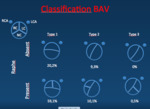Purpose
•To discuss the current knowledge of the anatomy,
pathophysiology and clinical aspects of bicuspid aortic valve disease (BAV)
•To review the role of different imaging techniques in the assess of BAV disease including echocardiography,
MDCT angiography and cardiac magnetic resonance
•To comment which aspects of each techniques the radiologist has to report in order to be useful to the clinician and surgeon
Methods and Materials
BAV disease is the most common congenital anomaly of the human heart with a prevalence between 1% and 2% with a male preponderance.
It is thought that the true incidence of BAV in the general population may be underestimated.
The reported prevalence of BAV-related aortic dilatation ranges from 33%-80%.
It is worth noting that aortic root dilatation is an important predictor of dissection and rupture in BAV-associated aneurysms,
even if the aortic valve is normally functioning.
•What to look for: When BAV is present,
always...
Results
Ecocardiography (Fig 4-7).
The mainstay of diagnosis is echocardiography (transthoracic or transesophageal).
Nevertheless,
due to the natural history of BAV to lead to heavily calcified stenotic calves,
the utility of echocardiography can be limited.The parasternal short axis view allows for direct visualization of the valve cusps.
The normal triangular opening shape is lost,
becoming more “fish mouth” like in appearance (usually in systole).Echocardiography can identify other cardiac abnormalities including vegetations,
systolic disfunction,
and visualisation of part of the aortic root (generally the first 3-4 cm)....
Conclusion
•BAV is a prevalent congenital disease with a wide range of symptoms.
Sometimes the diagnosis is made incidentally by the radiologist.
•The correct evaluation of BAV include the study of the aorta in order to look for associated disease.
•Although echocardiography is the mainstay technique,
cardiac MR and MDCT play a crucial role in the planning of either surgical and new treatments.
References
•Hope MD,
Hope TA,
Meadows AK,
et al.
Bicuspid aortic valve: Four-dimensional MR evaluation of ascending aortic systolic flow patterns
•Hayashida K,
Bouvier E,
Lefèvre T,
et al.
Transcatheter aortic valve implantation for patients with severe bicuspid aortic valve stenosis.
Cir Cardiovasc Interv 2013;6:284-91
•Delgado V,
Tops LF,
Schuijf JD,
et al.
Succesful deployment of a transcatheter aotic valve in bicuspid aortic stenosis: role of imaging with multislice compted tomography.
Cir Cardiovasc Imaging 2009;2:e12-3
•Malaisrie SC Carr J,
Mikati J,
et al.
Cardiac magnetic resonance...





